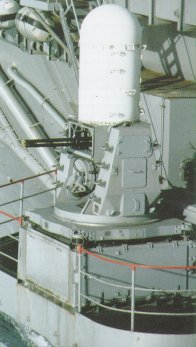Operating Systems
 Previous Section - Gas
The Gatling gun is perhaps the historically oldest
operating system described here.
Unlike blowback, recoil and gas operation, cycling energy
is typically not derived from the fired cartridge
but from external sources.
Though fundamentally different from the other systems
and never found in man-portable form,
Gatling's current significance warrants inclusion here.
Previous Section - Gas
The Gatling gun is perhaps the historically oldest
operating system described here.
Unlike blowback, recoil and gas operation, cycling energy
is typically not derived from the fired cartridge
but from external sources.
Though fundamentally different from the other systems
and never found in man-portable form,
Gatling's current significance warrants inclusion here.
When first deployed around 1865 Gatling's guns employed hand cranks
to control cycling and firing.
In most modern applications cycling energy comes from
external electric or hydraulic motors. The significant
task of accelerating massive ammunition feed belts is also
usually delegated to motors.
Note that some models do derive partial operating energy from
ammunition gases.
The continuous rotary motion of the barrels and smooth
movement of other elements helps attain high cyclic rates.
These motions resemble those found in high-speed
manufacturing systems.
 The modern Gatling gun is usually composed of 3 to 7 barrels
in a circular array. In operation, the barrels
and inner receiver rotate together. Independent bolts,
one aligned and moving with each barrel, follow a helical
cam track in the outer receiver. The cam track controls
the feeding, locking, and extracting functions
by moving each bolt fore and aft relative to its barrel.
The timing of the system is fixed by the position of the
bolt in track versus rotation. Each bolt typically
contains its own striker or other firing device.
(Cannon cartridges are usually electrically primed.)
The modern Gatling gun is usually composed of 3 to 7 barrels
in a circular array. In operation, the barrels
and inner receiver rotate together. Independent bolts,
one aligned and moving with each barrel, follow a helical
cam track in the outer receiver. The cam track controls
the feeding, locking, and extracting functions
by moving each bolt fore and aft relative to its barrel.
The timing of the system is fixed by the position of the
bolt in track versus rotation. Each bolt typically
contains its own striker or other firing device.
(Cannon cartridges are usually electrically primed.)
Until about 1950 the Gatling gun was considered a 19th
century anachronism. Then, demand for longer-range rapid-fire
aircraft guns saw the revival of this concept in
the form of the 20mm Vulcan automatic cannon.
The Vulcan cannon, and its' copies and derivatives remain
widely deployed in fighter aircraft throughout the world.
Other special applications include use with
the awesomely powerful 30mm round in the Fairchild A-10
"tank buster" ground attack aircraft, and the 20mm Phalanx
Close In Weapons System (abbreviated CIWS and pronounced "see-wiz")
used aboard U.S Navy ships as a last-ditch defense
against sea-skimming missiles such as Exocet.
The Gatling-derived Vulcan system was also scaled down
for use in helicopters and fixed-wing gunships during
the Vietnam era as the 7.62mm NATO-cartridged General Electric Minigun.
Next Section - Chain

 Back to Operating Systems Index
Back to Operating Systems Index
 Back to Index
Back to Index
 The modern Gatling gun is usually composed of 3 to 7 barrels
in a circular array. In operation, the barrels
and inner receiver rotate together. Independent bolts,
one aligned and moving with each barrel, follow a helical
cam track in the outer receiver. The cam track controls
the feeding, locking, and extracting functions
by moving each bolt fore and aft relative to its barrel.
The timing of the system is fixed by the position of the
bolt in track versus rotation. Each bolt typically
contains its own striker or other firing device.
(Cannon cartridges are usually electrically primed.)
The modern Gatling gun is usually composed of 3 to 7 barrels
in a circular array. In operation, the barrels
and inner receiver rotate together. Independent bolts,
one aligned and moving with each barrel, follow a helical
cam track in the outer receiver. The cam track controls
the feeding, locking, and extracting functions
by moving each bolt fore and aft relative to its barrel.
The timing of the system is fixed by the position of the
bolt in track versus rotation. Each bolt typically
contains its own striker or other firing device.
(Cannon cartridges are usually electrically primed.)
 Previous Section - Gas
Previous Section - Gas
